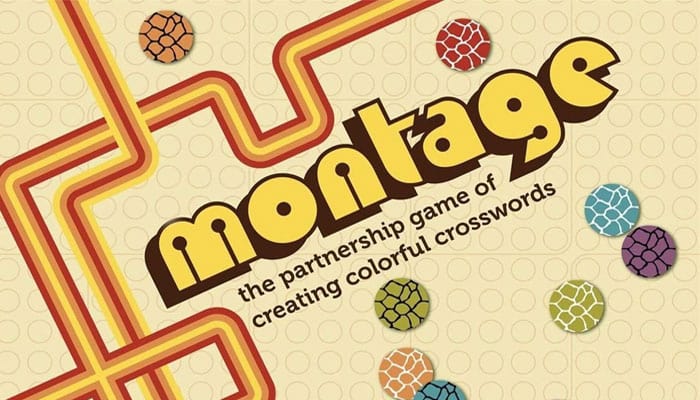
MONTAGE is a partnership word game for 4 players played on a board of 9 'zones' using colored chips. Invented by Joli Quentin Kansil in 1973, several games experts consider Montage to be the most original of the 36 games he has designed.
In Montage, each of the 5 different colored chips represents 5 or 6 letters of the alphabet and so all words are made with colors! The side that earns 4 zones first is the winner.

Components
- 240 double-sided colored chips
- 4 player reference cards (2 black, 2 white)
- 1 game board
- 50 pips (dark brown disks)
- 1 pointer
- 1 clock
- Instructions
Setup
Partners sit across from each other with the Montage board placed in the center of the table, and the Reference Cards placed on all 4 sides (see below). The board never has to be turned or moved during the game.
The 1-minute timer is placed near any corner of the board, and the colored chips (excluding the dark brown ones) are divided randomly into 2 piles and placed at 2 opposite corners of the board.
The montage board is divided into 9 equal zones of 25 circles each: 1 middle zone, 4 corner zones, and 4 home (side) zones. The home zone in front of each player and the two corner zones adjacent to it are called a player's home side.
Pattern
The players choose one of the symmetrical patterns (see examples provided) and proceed to lay it out using the dark brown chips, which are called pips. (The first pattern shown, America, is ideal for beginning players).
A pip on the board corresponds to a shaded or blacked-in square in a typical crossword puzzle. The pip aids in showing the length of a word and in separating one word from another.
Seeding
The yellow circles which form the large diamond on the board are randomly filled with colored chips before play starts. One partnership is designated to be Black, the other, White.
To seed the large diamond, one player takes a handful of colored chips and drops them one at a time in the yellow circles.
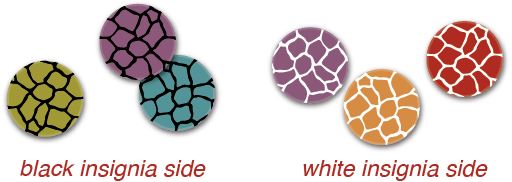
If a pip has already been placed on one of the yellow circles as part of the game pattern, that circle is skipped in seeding. Chips used in seeding are placed with either a black or white insignia face up conforming to the black and white inner circles on the large diamond.
(See the Set Up illustration of the America pattern, which shows a board that is seeded and ready for play).
To determine which partnership goes first, any player flips a colored chip and if it lands with the black side up, Black goes first; if it lands white, then White has first play.

The Quizzer
The player whose turn it is to play is called the Quizzer. To start play, either opponent turns over the 1-minute timer.
Quizzer then thinks of where he or she will play and indicates this by placing the pointer (arrow) adjacent to the first letter of the word he or she wishes to make, pointing the arrow in the direction the word will read.
Words may read left to right, or right to left, either horizontally or vertically. Indicated words must start and end either at brown pips or between brown pips and the edge of the board.
Once the pointer is down, it may not be moved, except that Quizzer may choose to reverse the direction that the word will read by placing the pointer at the other end of the word and turning the arrow so that it points the opposite way.
Colored Chips
Each of the 26 letters of the alphabet is assigned to 1 of 5 color groups:

Each group has 4 consecutive letters of the alphabet, excluding the 5 least frequent letters, which are assigned 1 to each group. The green group has a 6th letter - Y - that is used as either a vowel or a consonant; the other 5 vowels - A, E, I, O and U - are assigned 1 to each group.
Forming Words
In Montage, words are formed by arrangement of colored chips rather than with individual letters. For example, DOG would be 'spelled' orange-blue-red, and WAFER would be green-orange-red-red-blue.
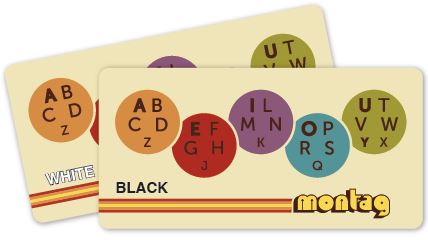
Transferring letters into colors is soon an easy task, and the reference card provided is useful for this purpose. Once a word is placed on the board, a chip in it may stand for any letter in the group when a word is placed in a different direction.
To illustrate, if MONTH is placed horizontally, the red chip - H - in MONTH may stand for any red letter - E F G H or J - when a word is put down vertically.
Access
Quizzer is limited to where he is allowed to place the pointer to make a word: Quizzer may play only to a word in his home zone until it is completely filled with chips. Then he or she may play to either adjacent corner zone. When the home side is completely filled, Quizzer may play anywhere on the board.
If a word crosses from the home zone to another zone, Quizzer may play to it only if at least 2 of the circles in the word are in the home zone.
Quizzer may play only to an open word, which is a word that has at least 1 chip already placed down. An open word with 1 chip down is called a singlet; with 2 chips down, a doublet; with 3, a triplet; and with 4, a quadruplet.
Usually Quizzer will elect to play to either a doublet or triplet. In the Set Up - America Pattern, note that each Quizzer at the first turn can play to 10 different open words, 2 of which are doublets. Since a word may read in either direction, this means that there are 15 different plays available.
Clues
Having thought of a word and placed the pointer, Quizzer then gives a clue of up to 5 words.

The other 3 players think of the answer to the clue. Quizzer's clue may be a straight definition, an association clue, a familiar expression or quotation substituting 'blank' where the answer goes, or a pun or other type of play-on-word clue.
For example, if Quizzer's answer were PIE, any of the following clues would be acceptable:
- kind of cake
- apple or lemon
- as easy as 'blank'
- mathematician's dessert
If the answer were SPADES, possible clues would be:
- digging implements
- 1 of 4 suits
- ace of 'blank'
- poker players' shovels
Quizzer may not spell any words in the clue, and the following types of clues are barred from the game: 'rhymes', 'opposites', clues that contain the answer within, and clues of more than 5 words. To illustrate, if the Quizzer's answer were OLD, all of the following clues would NOT be allowed:
- rhymes with bold
- opposite of new
- describing an 80-year-old
- you are only as 'blank' as you feel (8-word clue)
Legal Words
In Montage, a word to be used as an answer may be any word found in the dictionary, plus proper nouns such as boys' names, famous last names, and noted cities.
Also acceptable are slang expressions, abbreviations, common foreign words - virtually anything that is public knowledge and which has not been barred from use by the partnerships prior to the start of play.
Knocking
A player is never permitted to shout out the answer to the Quizzer's clue. Rather, he or she signals a willingness to answer by knocking once on the table. A player's knock is valid only if it occurs before the clock (1-minute timer) runs out.
The player who can think of the answer first and indicates this by knocking on the table gets to answer, with one exception: Quizzer's partner has an advantage in that if he or she knocks first or second, this player gets to answer.
Quizzer indicates which player shall respond by pointing to that player or by calling his or her name. The player answering is designated as the Responder. Here are all of the different knocking possibilities:
No player knocks: When the clock runs out, Quizzer announces the answer, and no chips are put down on the board.
1 player knocks: When it is an opponent, the clock continues to run. If no other player knocks before the clock runs out, Quizzer designates that opponent to answer. If only Partner knocks, Quizzer immediately points to him or her to answer; there is no waiting for another player to answer.
2 players knock: One of the 2 players is immediately given the right to answer, and Quizzer points to that player without waiting for the clock to run out.
When Partner and 1 opponent knock, Quizzer points to Partner to answer - even if Partner knocked after the opponent. When both opponents knock, Quizzer points to the opponent of his or her choice who then answers.3 players knock: If the knocks were not in rapid succession, the final knock is disregarded and the procedure is as if there were 2 knocks; otherwise, Quizzer points to either opponent to answer (thus discouraging very easy clues).
Finally, if an opponent knocks and then the other 2 players knock virtually together, Quizzer points to either opponent to answer, and that Responder must then answer immediately. Quizzer is the final judge as to whether or not there have been simultaneous knocks.
Placing Chips
When Partner is Responder and answers correctly, Quizzer's team "gains the word". Quizzer places the word on the board with the appropriate colored chips and with the insignia of Quizzer/Partner (either black or white side up).
When an opponent is Responder and answers correctly, Quizzer places the word down with the insignia of the opponents. When initially placing chips for correct answers, do not turn over opponents' chips already on the board. This only happens when a zone is won (see WINNING ZONES).
Example: In the Set Up - America Pattern, the player in the South position is Quizzer and is White. This Quizzer chooses to play to the horizontal doublet which has orange chips seeded in the second and fourth positions of the word.
Quizzer places the pointer and gives the clue 'tennis competition'. Partner knocks second and becomes Responder and answers 'MATCH'.
Quizzer then places 3 more chips on the board with the white insignia face up: a purple chip to represent M, a green chip for T, and a red chip for H, spelling MATCH in colors: PURPLE-ORANGE-GREEN-ORANGE-RED.
Alternate Answer
An answer is deemed correct if it fits the clue given. It need not be the same answer that Quizzer had in mind. In such case, the alternate correct answer is the one that is placed with chips.
Example: Quizzer places the pointer to a doublet 5-letter word, which has a purple chip in the second position and a red chip in the fifth position. Quizzer gives the clue 'sharp instrument'.
Partner knocks first and answers KNIFE, but Quizzer had in mind BLADE. Both words fit, and so KNIFE is put down as the correct answer.
Incorrect Answer
If Quizzer's Partner is Responder and answers incorrectly, then the first opponent who knocked attempts to answer immediately and, if correct, gains the word and the clock passes to the left.
If an opponent is Responder and answers incorrectly, then Quizzer's Partner attempts to answer immediately and, if correct, gains the word and retains the clock if appropriate (see THE CLOCK below). If all answers are incorrect, no partnership gains the word and the clock passes to the left.
The Clock

When an opponent is Responder and answers correctly, or when no players knock to answer, the 'clock passes', and the turn to play moves on with the left opponent becoming the next Quizzer.
When Partner is Responder and answers correctly, that side 'keeps the clock' if Quizzer has played to a doublet, triplet, or quadruplet; if Quizzer has played to a singlet, the clock passes - unless there are only singlets remaining in the zone where Quizzer is playing.
Thus, as long as Partner answers correctly and Quizzer has played to at least a doublet or a 'forced singlet', Quizzer keeps the clock.
Note in the America pattern, Quizzer has 2 doublets to play to at the first turn. If Quizzer instead chooses to play to a singlet, the clock would automatically pass regardless of who was Responder.
When the clock has run a full minute and no player has earned the right to answer, any player may indicate that time is exhausted by saying 'Time'.
Winning Zones
The partnership that first succeeds in having 10 chips of their insignia placed face up in a zone wins that zone, and all remaining open circles in the zone are filled in immediately with chips of their partnership insignia.
To implement this, whoever is Quizzer at the time takes a handful of chips at random (as when seeding the board at the beginning of the game) and deposits each chip quickly to the board with the winning partnership's insignia side up.
In addition, all chips of the losing players' insignia are turned over so that every chip in the zone shows the winning insignia.
When there are more than 6 pips in a zone, it is possible that neither side will win 10 chips. In this case, the side placing the last chip in the zone wins the zone - even if that partnership has not won more chips than the other side.
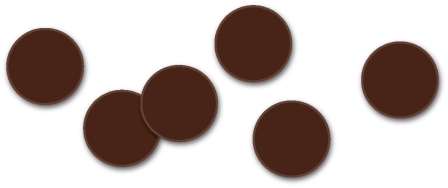
End of the Game
The first side that earns 4 zones wins the game.
What If
Below are explanations regarding procedures for clues or answers that may be questionable, or other clarifications to the game.
If Responder's answer cannot fit into the circles that have been designated with the pointer, or if the answer does not fit the clue given, it is deemed incorrect and the other side gains the word just as if that side had answered correctly. Quizzer is the final judge as to whether an answer is valid.
If a player answers before waiting until after he has knocked and been recognized by Quizzer, the other side gains the word whether or not the 'pre-emptive' answer was correct.
If a player knocks and has earned the right to answer immediately, but fails to do so when pointed to, the other side gains the word.
An opponent of Quizzer may bluff by knocking, even though he or she is unable to supply the answer. If this opponent is the player who is called upon and fails to answer correctly or respond at all, Quizzer's side gains the word.
A word placed down may not be put down again in the same game. The same clue, however, may be used again in the same game.
If the opponents judge Quizzer's clue to be incorrect, the letter circles where the pointer was are filled in with the opponents' insignia using random chips (just as in seeding the board). Play then passes to the left.
When chips are placed on the board to form a word in one direction and this results in any 'words' being formed in the other direction, such event has no effect on the play, and Quizzer is not responsible for supplying an answer for any extra 'words' made in this way.
There is considered to be an unlimited supply of chips of each color. In the rare case where a color runs out, chips of that color may be taken from a zone that is completed, and other colored chips at random can be placed where these chips were taken from.
Championship

In Championship Montage, play continues until all 9 zones of the board have been filled with chips, thus creating a beautiful montage of colors.
The game is then scored with the winning side earning anywhere from 1000 points for a 'Single Victory' to 10,000 points for a 'Grand Montage'.
Scoring
The rules of play are the same as for standard Montage. When the entire board is filled with chips, the winning partnership is the side that has earned the majority of zones.
The number of zones earned by the winners determines the amount of points scored.
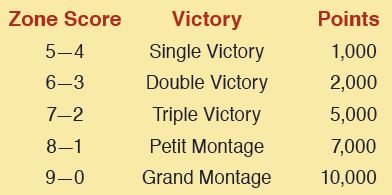
Continue Reading
